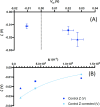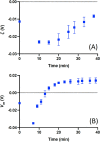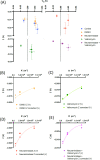Vm-related extracellular potentials observed in red blood cells
- PMID: 34593849
- PMCID: PMC8484267
- DOI: 10.1038/s41598-021-98102-9
Vm-related extracellular potentials observed in red blood cells
Abstract
Even in nonexcitable cells, the membrane potential Vm is fundamental to cell function, with roles from ion channel regulation, development, to cancer metastasis. Vm arises from transmembrane ion concentration gradients; standard models assume homogeneous extracellular and intracellular ion concentrations, and that Vm only exists across the cell membrane and has no significance beyond it. Using red blood cells, we show that this is incorrect, or at least incomplete; Vm is detectable beyond the cell surface, and modulating Vm produces quantifiable and consistent changes in extracellular potential. Evidence strongly suggests this is due to capacitive coupling between Vm and the electrical double layer, rather than molecular transporters. We show that modulating Vm changes the extracellular ion composition, mimicking the behaviour if voltage-gated ion channels in non-excitable channels. We also observed Vm-synchronised circadian rhythms in extracellular potential, with significant implications for cell-cell interactions and cardiovascular disease.
© 2021. The Author(s).
Conflict of interest statement
MPH is a director of Deparator, which manufactures the 3DEP instrument used for the DEP measurements. The authors declare no other interests.
Figures







References
-
- Galvani, L. De viribus electricitatis in motu musculari commentarius (Ex Typographia Instituti Scientiarum; 1792).
-
- Nernst, W.H. Die elektromotorische wirksamkeit der Jonen (W. Engelmann, 1889).
MeSH terms
Substances
LinkOut - more resources
Full Text Sources

